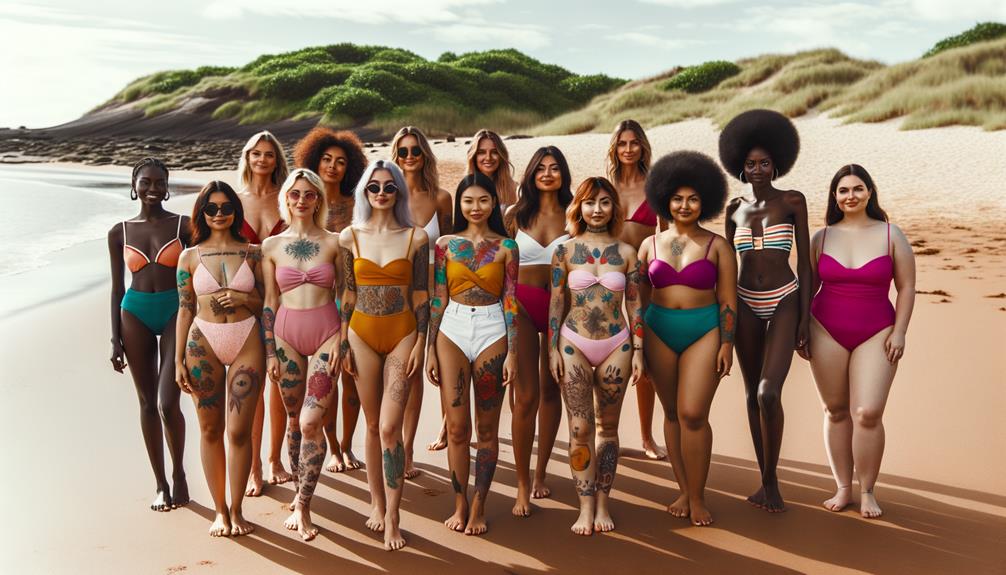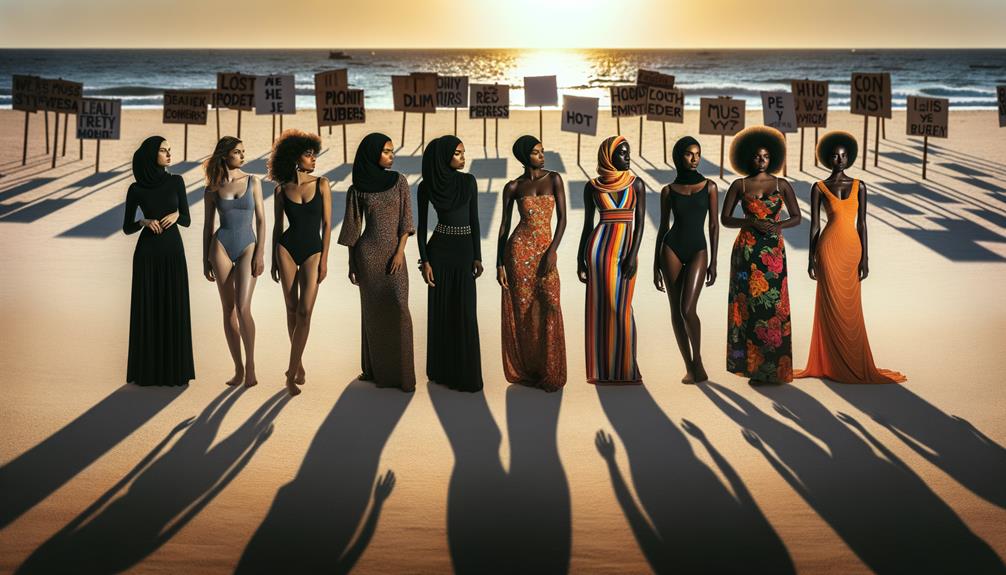The recent Moana Bikini campaign featuring a male model in women's swimwear has certainly sparked a lively debate around gender and inclusivity. Some argue it undermines female empowerment, while others see it as a step toward greater representation. It's a complex issue, intersecting body positivity and gender norms.
Public reactions range from fierce resistance to enthusiastic support, reflecting the ongoing tension in our society between tradition and progress. This episode reveals deep-seated societal tensions and the challenges in achieving genuine inclusivity. There's more to unpack beneath the surface.
The Controversial Launch
The recent launch of Moana Bikini's campaign featuring a male model in a women's swimsuit has sparked a heated debate. As I observe the reactions, I can't help but consider the broader implications for body-positivity and inclusivity within the swimwear industry.
By placing Jake Young, a male model, in a $99 one-piece bikini, Moana Bikini challenges traditional notions of gender and sexuality. This bold move has divided opinions, with some critics arguing it undermines female empowerment, while others see it as a step toward greater inclusivity.
The criticism has been fierce, with detractors accusing the brand of giving men power over women and suggesting men 'do it better.' Such comments reveal deep-seated anxieties about gender roles and the visibility of minority groups. Yet, Moana Bikini stands by its decision, asserting its commitment to being one of the most inclusive and empowering brands.
Jake Young himself has spoken out, emphasizing his role in empowering a minority rather than appropriating women's spaces. This controversy highlights the complex interplay between gender, body-positivity, and empowerment in the swimwear industry. As society evolves, so too must our understanding of what inclusivity and representation truly mean.
Reactions From Public Figures
Many public figures have weighed in on the debate over including male models in women's swimwear campaigns. The reactions reveal deep divisions and strong emotions on the topic.
Megyn Kelly's scathing critique of Target's tuck-friendly bathing suits sparked heated discussions. She asserted that women don't need such features because "they do not have penises," a view that resonated with those who feel traditional gender lines are being blurred unnecessarily.
Kayleigh McEnany expressed concern about the rapid pace of what she calls companies going "woke," raising questions about whether there's a coordinated effort behind these inclusive campaigns or if it's a genuine shift toward acceptance.
Riley Gaines and Rep. Nancy Mace took to social media to voice their fears that campaigns featuring male models in bikinis are "erasing women" from pop culture. Their statements resonate with people who feel women's spaces are being encroached upon.
On the other hand, Adidas' collaboration with Athlete Ally aims to celebrate LGBTQ+ identities and create inclusive, empowering brands. By including a gay man in a women's bathing suit campaign, they make a bold statement about acceptance and minority representation. It's a nuanced issue, reflecting broader societal shifts and the tension between tradition and progress.
Debate on Gender Representation

The debate on gender representation in swimwear campaigns often reveals deep-seated beliefs and cultural tensions that challenge how we understand identity and inclusivity. Seeing a male model confidently wearing bikini swimwear can be both empowering and controversial. It forces us to reflect on the intersections of clothing, sexuality, and acceptance.
The feedback on these campaigns is mixed and polarized. Some celebrate the boldness and inclusivity, while others react with homophobic disdain. This starkly highlights the resistance that still exists towards progressive representation.
It's fascinating how a simple change in marketing can stir such strong emotions and provoke widespread discussion. Consider the following:
- Visibility and Representation: Having diverse models, including male models in traditionally female clothing, broadens our understanding of gender norms.
- Empowerment through Clothing: The act of wearing what was once deemed inappropriate for one's gender can be a powerful statement of self-acceptance and confidence.
- Cultural Backlash: The controversy often reveals underlying societal prejudices, making it clear how much more progress is needed towards genuine inclusivity and acceptance.
These debates are essential, as they expose the fractures and potential for growth within our collective societal mindset.
Advertising and Inclusivity

In observing the current advertising landscape, it's clear that efforts to promote inclusivity are challenging and redefining traditional norms. Fashion advertising, particularly in swimwear, has become a battleground for discussions about representation and diversity. When the brand Moana Bikini featured a male model, Jake Young, in a $99 one-piece swimsuit, it sparked swift backlash. Critics argued this move wasn't empowering women and accused the brand of allowing men to encroach on women's fashion and identity.
However, Moana Bikini defended its stance, highlighting a commitment to inclusion across all races, ethnicities, body shapes, genders, and sexual orientations. This defense underscores the evolving definition of body positivity and gender identity within the fashion industry. Jake's gratitude for the opportunity speaks volumes about the importance of LGBTQ+ representation. He pointed out that the criticism often reflects more about the insecurities of the commenters than about the campaign itself.
Similar instances at other brands, like Seafolly, reveal persistent tensions. Customer feedback often oscillates between support and backlash, illustrating the complexities of navigating these progressive waters. The fashion industry's journey toward inclusivity is fraught but necessary for genuine representation.
Broader Societal Implications

The ongoing debates about gender identity in swimwear fashion reveal deeper societal tensions around inclusivity and the evolving definition of identity. When a male model was featured in Moana Bikini's campaign, the backlash exposed the friction between traditional gender norms and the push for broader gender representation. This isn't just about a single piece of clothing; it reflects what that clothing symbolizes in our society.
While some see these changes as steps toward gender empowerment and inclusivity, others perceive them as threats to established social norms. The controversy over Target's tuck-friendly swimsuits and LGBTQ+-themed children's clothing underscores this divide. It's a clear reflection of the broader cultural tensions surrounding gender expressions and the acceptance of diverse identities.
Consider these points:
- Gender Polarization: The backlash demonstrates how polarized our society remains on issues of gender identity and representation.
- Diversity and Inclusion: Providing a variety of options for different gender identities can foster a more inclusive environment.
- Gender Empowerment: Allowing individuals to express their gender through fashion can be empowering, contributing to greater acceptance and understanding.
Ultimately, these debates underscore the ongoing challenge of balancing tradition with the need for diversity and inclusion in our modern world.
Frequently Asked Questions
What Is the Adidas Swimsuit Controversy?
The Adidas swimsuit controversy revolves around their inclusive swimwear line, which some argue breaks traditional norms. It's seen as a bold, innovative step towards diversity, but has sparked intense debate on societal expectations and acceptance.
The swimsuits, which include options for different body types and coverage preferences, have faced backlash from those who believe they deviate from conventional swimwear designs. Critics argue the suits challenge traditional perceptions of what constitutes "appropriate" beachwear.
On the other side, supporters praise Adidas for embracing inclusivity and providing options that cater to a wider range of body shapes and personal comfort levels. They view the collection as a positive move towards greater representation and self-expression in the fashion industry.
The debate highlights the tensions between societal norms, personal freedom, and the evolving landscape of acceptable attire. As attitudes continue to shift, the Adidas swimsuit controversy has become a flashpoint for discussions around body positivity, cultural change, and the boundaries of acceptable fashion.
Why Were Speedos Banned?
Speedos were banned in the past because they were seen as too revealing and indecent, clashing with the conservative norms of the time. It's interesting how societal attitudes have evolved, allowing once-taboo swimwear to become accepted and even celebrated today. Swimwear trends reflect the changing values and comfort levels within a culture. What was once considered scandalous can now be commonplace, as people become more open-minded and tolerant of different forms of self-expression.
What Did the Original Bikini Look Like?
The original bikini was a daring design that revealed the navel and a significant portion of the torso. Created by Louis Réard in 1946, it was both scandalous and revolutionary, challenging the societal expectations of modesty. The skimpy two-piece swimsuit made waves, pushing the boundaries of acceptable beachwear at the time.
How Has Swimwear Changed Over Time?
Swimwear has undergone a remarkable transformation over the years. We've come a long way from the modest, full-body suits of the past to the daring bikinis of today. But the change isn't just about fashion – it reflects a broader shift in societal attitudes and representation.
Social media has amplified discussions around body positivity and empowerment, pushing brands to innovate and diversify their swimwear offerings. Consumers now demand styles that cater to a wide range of body types and personal preferences, moving away from the one-size-fits-all approach of bygone eras.
The modern swimwear landscape celebrates inclusivity, with designers embracing bold, expressive designs that empower wearers to feel confident and comfortable in their own skin. Gone are the days of restrictive, cookie-cutter swimsuits; today's offerings prioritize self-expression and personal style.
This evolution in swimwear mirrors the growing recognition that beauty comes in all shapes and sizes. Brands are responding by showcasing diverse models, challenging traditional beauty standards and encouraging a more inclusive, body-positive culture.
Conclusion
Bikini swimwear has sparked a heated debate, reflecting our evolving views on gender and inclusivity. While some call for traditional norms, others advocate for change. This controversy goes beyond the fabric itself – it challenges us to rethink societal expectations and embrace a more diverse future.
The reactions have been widespread, like a modern clash of ideas and values. It's not just about the swimsuit; it's a mirror reflecting our shifting perspectives on what's acceptable and who gets to decide. Some voices defend the status quo, while others push for progress.
Ultimately, this debate is about more than just clothing. It's a chance to examine our deepest assumptions and work towards a more inclusive society. The way we approach this issue will shape the path forward, whether we cling to the past or open ourselves to new possibilities.



